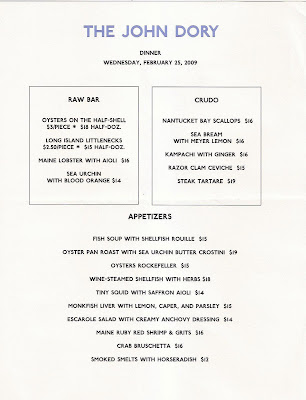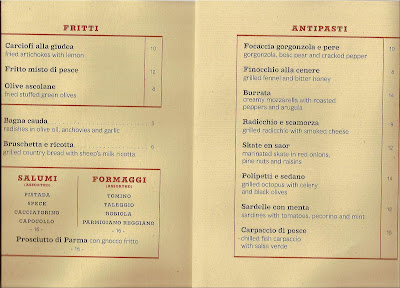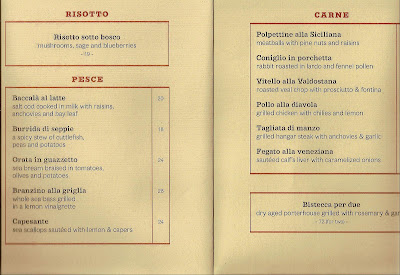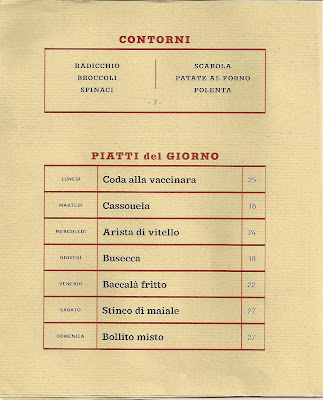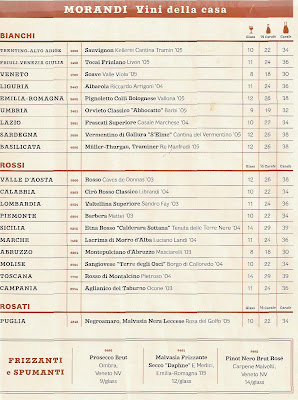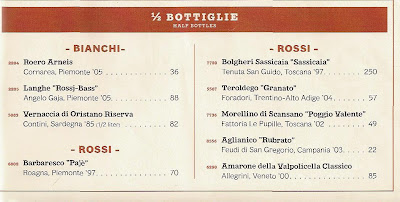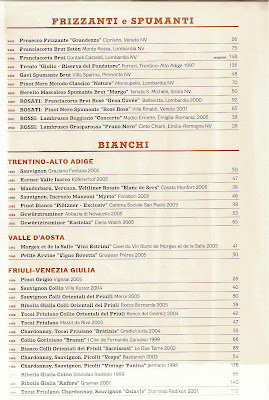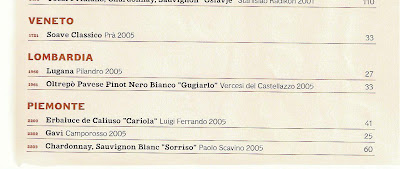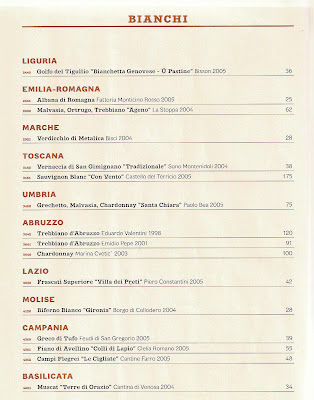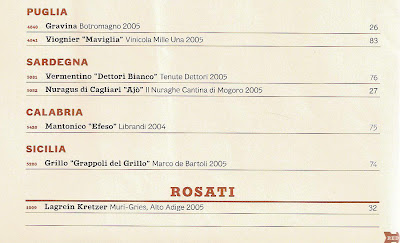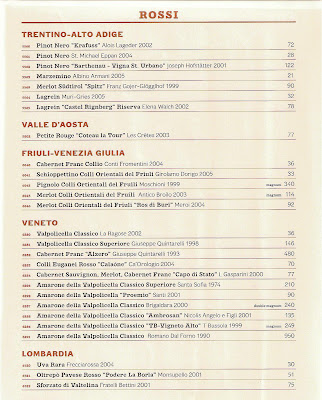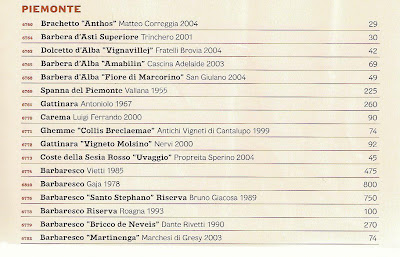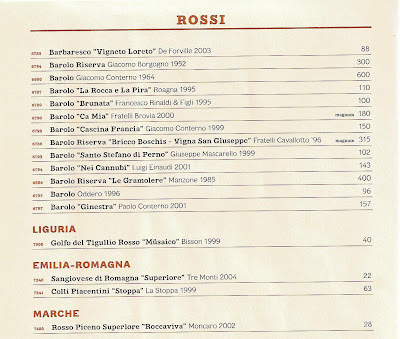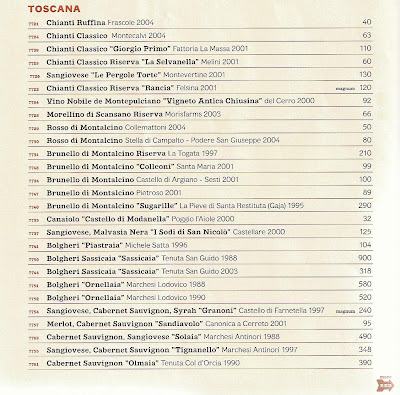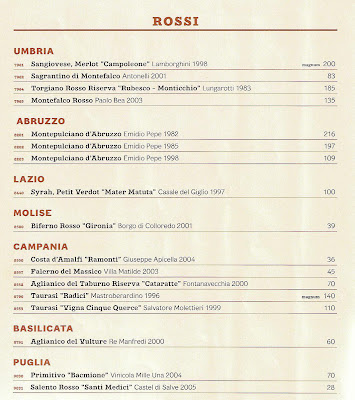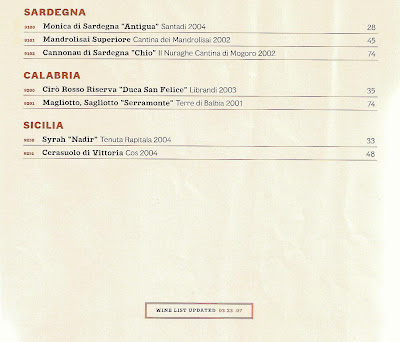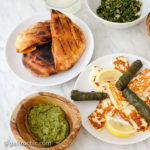Tag Archives: seafood
Alchemy, Martha’s Vineyard
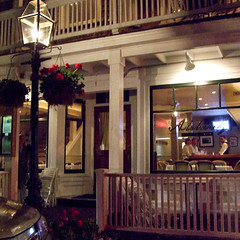 Dining out in a seaside town can be a mixed bag. On the one hand, you have access to the freshest seafood around; on the other, nearly anyone can put up a sign like “Best Lobster Rolls!” and tourists won’t be any the wiser.
Dining out in a seaside town can be a mixed bag. On the one hand, you have access to the freshest seafood around; on the other, nearly anyone can put up a sign like “Best Lobster Rolls!” and tourists won’t be any the wiser.
Fortunately, Martha’s Vineyard has a large year-round population of about 15,000, slightly larger than Nantucket and more than enough to sustain a restaurant that wants to go above and beyond tourist fare. And many summer people, like our generous hosts, captains of the S.S. Sapphire, have been coming to this idyllic spot for decades. Word gets around fast when there’s a good restaurant in town – or when something new is not worth the hype.
Alchemy in Edgartown is a French-style bistro in traditional New England clothing – muted colors, wainscoting, ivy topiaries. The only thing old-school about the food, however, is the local ingredients like scallops, peas, and oysters, which are just the starting point for the culinary wizardry that ensues. (more…)
How to Throw a Crawfish Boil
 Barbecues may be fun, but there’s nothing quite like sitting around a pile of spicy seafood with friends and a cold beer on a summer day. The next time you have an outdoor party, consider throwing a crawfish boil.
Barbecues may be fun, but there’s nothing quite like sitting around a pile of spicy seafood with friends and a cold beer on a summer day. The next time you have an outdoor party, consider throwing a crawfish boil.
This Louisiana staple is not as hard to pull off as it sounds. Getting the crawfish? Just start working the phones. We got ours from Mr. Fish in Baltimore. In New York, try the Lobster Place in Chelsea Market, where it was most recently $4.75 per pound – call several days ahead of time to special order. (more…)
The John Dory
CLOSED
 The problem with seafood is that it’s become another word for “diet.” Just as diners have their “diet plate” section with the cottage cheese and fruit plate, nearly every restaurant now offsets decadent meat dishes with an obligatory light seafood dish. The ploy is so obvious that they might as well have an asterisk after these neglected fish entrees – “for the ladies!” And because a plain fillet of fish can’t put up much of a fight against meatballs or pork belly, most non-dieters have been ignoring fish altogether.
The problem with seafood is that it’s become another word for “diet.” Just as diners have their “diet plate” section with the cottage cheese and fruit plate, nearly every restaurant now offsets decadent meat dishes with an obligatory light seafood dish. The ploy is so obvious that they might as well have an asterisk after these neglected fish entrees – “for the ladies!” And because a plain fillet of fish can’t put up much of a fight against meatballs or pork belly, most non-dieters have been ignoring fish altogether.
 Well, no longer. There’s nothing remotely “diet” about the seafood at The John Dory. Chef April Bloomfield of the Spotted Pig has found the fat in fish, or when it’s not there, added it in the form of butter aplenty. How unladylike! But if her goal is to bring hearty, pub-style seafood to New York, she has certainly exceeded it. The most exciting fish dish I remember eating in London would be the excellent fish and chips at Geales in Notting Hill.
Well, no longer. There’s nothing remotely “diet” about the seafood at The John Dory. Chef April Bloomfield of the Spotted Pig has found the fat in fish, or when it’s not there, added it in the form of butter aplenty. How unladylike! But if her goal is to bring hearty, pub-style seafood to New York, she has certainly exceeded it. The most exciting fish dish I remember eating in London would be the excellent fish and chips at Geales in Notting Hill.
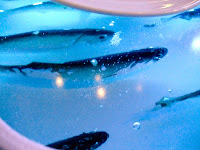 The whole aesthetic of the place is very appealing: old school nautical, like a seaside restaurant you’d stumble upon in a tiny resort town. What makes it citified is the obvious expense that went into it, plus lots of visual puns like the lures “swimming” in the resin countertop of the bar, and the lighted tank of real fish doomed to watch their brethren being consumed – which may be why it’s also the site of an infamous eel suicide incident.
The whole aesthetic of the place is very appealing: old school nautical, like a seaside restaurant you’d stumble upon in a tiny resort town. What makes it citified is the obvious expense that went into it, plus lots of visual puns like the lures “swimming” in the resin countertop of the bar, and the lighted tank of real fish doomed to watch their brethren being consumed – which may be why it’s also the site of an infamous eel suicide incident.

 The most difficult thing about the menu is deciding what to order, since there are so many appealing things on it. Marie Fromage and I started from square one, a mix of East and West Coast oysters, which were fresh, clean, alternately salty and sweet, and accompanied by an interesting mignonette made of peppers instead of the usual shallots.
The most difficult thing about the menu is deciding what to order, since there are so many appealing things on it. Marie Fromage and I started from square one, a mix of East and West Coast oysters, which were fresh, clean, alternately salty and sweet, and accompanied by an interesting mignonette made of peppers instead of the usual shallots.
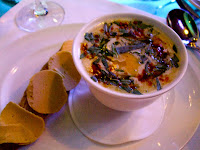 If there were one dish that summed up the direction of the food, it would be the fantastic oyster pan roast with sea urchin butter crostini. First you have excellent quality ingredients – huge, plump oysters, salty-fatty sea urchin, and fabulous butter – then you have the technique. The oysters are submerged in a buttery sauce with a slight vinegar/lemon edge to cut it, like a hollandaise laced with fresh tarragon. It gives another meaning to “slow food” – the only way to eat it is slowly.
If there were one dish that summed up the direction of the food, it would be the fantastic oyster pan roast with sea urchin butter crostini. First you have excellent quality ingredients – huge, plump oysters, salty-fatty sea urchin, and fabulous butter – then you have the technique. The oysters are submerged in a buttery sauce with a slight vinegar/lemon edge to cut it, like a hollandaise laced with fresh tarragon. It gives another meaning to “slow food” – the only way to eat it is slowly.
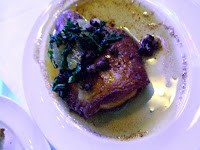 For the seafood equivalent of foie gras, look no further than this monkfish liver dish. This was seriously decadent and should only be attempted by true liver fans.
For the seafood equivalent of foie gras, look no further than this monkfish liver dish. This was seriously decadent and should only be attempted by true liver fans.
Of course we had to spring for the signature dish, the John Dory. The only problem is, you have to choose whether you want them to filet this fish for you ahead of time or if you want to do it yourself. This presented a sort of quandary, since I actually like to see (and photograph) the whole fish before I eat it. The alternative is rather disappointing, like carving a Thanksgiving turkey in the kitchen instead of at the table. And perhaps because the majority of the seating is at the bar, they don’t offer to filet it tableside. When the waiter disappeared, leaving us with a whole fish staring back at us from the plate, I felt like a flailing “Top Chef” contestant, racking my brain for some memory of fish fileting technique.
 When we did manage to hack it to pieces, it was quite good. The exterior had a wonderful char and the interior was light with an herbal perfume to it. The salsa verde was perhaps a little too acidic for the fish, but overall it was an excellent.
When we did manage to hack it to pieces, it was quite good. The exterior had a wonderful char and the interior was light with an herbal perfume to it. The salsa verde was perhaps a little too acidic for the fish, but overall it was an excellent.
We visited the John Dory right after Bruni’s review and were surprised he gave it two stars instead of three. The casual decor and open kitchen do seem at odds with the prices (our dinner cost $100 each including tip), but surely Bloomfield and Ken Friedman deserve points for the inventiveness mentioned in the lede. The best American seaside restaurants and London fish spots (including Geales) are also casually decorated – the prices match the fish.
The John Dory
85 10th Avenue, between 15th and 16th Streets
New York, NY
(212) 929-4948
Sfoglia Nantucket







Freshly caught sea bass is a special that night. It arrives at the table as a thick steak cut–not what my delicate friend was expecting–but it’s excellent nevertheless, redolent of smoke and char and perfectly cooked. Again Sfoglia turns to fresh local vegetables–in this case Swiss chard and fennel–as groundwork for the dish.


Kuku Canteen
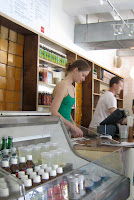 In the interest of full disclosure, it should be noted that I have a relationship with the restaurant featured in this review: The folks at Wawa Canteen prepare delicious food, and I eat it. Several times a week.
In the interest of full disclosure, it should be noted that I have a relationship with the restaurant featured in this review: The folks at Wawa Canteen prepare delicious food, and I eat it. Several times a week.
When a tiny Korean restaurant in central Greenwich Village closed a couple years back, neighbors were dismayed, expecting the usual NYU-geared smoothie/creperie/coffee shop to open in its place. But what arrived was Korean Restaurant 2.0, with a sleek design comprised of wood counters flanked by modern chairs, tiled walls and floors, and displays of rice and Sapporo lining the back wall. It’s now owned by Philip Rodrigue, who used to own the Cooler in the MPD. (He brought his excellent music collection with him.) What a relief to have an actual restaurant in this spot, and an approachable one, too. The ergonomic layout allows for quick service, because, as Rodrigue puts it, “You ought to be able to eat some decent food for $10 and be in and out in a half hour.”
Eureka. It’s the concept of a diner applied to ethnic food, in this case, Korean cuisine, which is underrepresented in New York compared to the plethora of Chinese, Japanese, and pan-Asian spots. Though Rodrigue says he was going for “generic eating,” the results are anything but. Consulting chef Donna Lee put a California spin on Korean food with home-cooking style dishes like surprisingly light kimchi fried rice.
 My first feeling upon biting into the kimchi fried rice with chicken was one of deep regret. Here I’d been eating at Wawa Canteen for nearly two years, and I’d never tried the best dish on the menu until now, in my quest to cover as many items as possible. The kimchi is so good – spicy, sweet, crunchy, tangy – and the sticky, fluffy rice has chili flecked throughout. Though this is traditional home cooking, the type you won’t find in Koreatown restaurant-style food, the presentation is elegant, with fine strips of nori on top. It’s exciting comfort food, and it can be habit-forming.
My first feeling upon biting into the kimchi fried rice with chicken was one of deep regret. Here I’d been eating at Wawa Canteen for nearly two years, and I’d never tried the best dish on the menu until now, in my quest to cover as many items as possible. The kimchi is so good – spicy, sweet, crunchy, tangy – and the sticky, fluffy rice has chili flecked throughout. Though this is traditional home cooking, the type you won’t find in Koreatown restaurant-style food, the presentation is elegant, with fine strips of nori on top. It’s exciting comfort food, and it can be habit-forming.
 Kimchi is an insanely popular ingredient here: during the NYU school year, Wawa goes through four 15-gallon vats of it in a week. Like a new pickle, Wawa’s kimchi retains that vegetable crunch that enlivens so many of the dishes here. The soft, barely sweet dough of the kimchi pajun is interlaced with strips of this crispy goodness, all of which goes beautifully with the slightly vinegary soy sauce.
Kimchi is an insanely popular ingredient here: during the NYU school year, Wawa goes through four 15-gallon vats of it in a week. Like a new pickle, Wawa’s kimchi retains that vegetable crunch that enlivens so many of the dishes here. The soft, barely sweet dough of the kimchi pajun is interlaced with strips of this crispy goodness, all of which goes beautifully with the slightly vinegary soy sauce.
 Of course, what kimchi also does is heat things up. Only the intrepid should opt for the kimchi stew, an incredibly spicy, sour concoction that blows away neighboring faux-Asian places whose food has too much sugar and not enough heat.
Of course, what kimchi also does is heat things up. Only the intrepid should opt for the kimchi stew, an incredibly spicy, sour concoction that blows away neighboring faux-Asian places whose food has too much sugar and not enough heat. 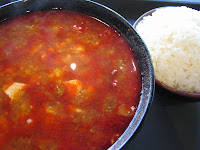 A red slick of chili oil on the soft tofu stew tells you this is one seafood dish that shouldn’t be taken lightly. Thankfully, the white rice served alongside helps put out the flames.
A red slick of chili oil on the soft tofu stew tells you this is one seafood dish that shouldn’t be taken lightly. Thankfully, the white rice served alongside helps put out the flames.
 If you can’t take the heat, never fear. Several dishes offer up healthy, vegetable-centric Korean food in a milder format. The best of the non-spicy bunch is the curry rice with chicken and vegetables. (Just ask for both chix and vegetables.) The rich sauce exudes a slow burn that complements the stewed potatoes, carrots, chicken, and beans.
If you can’t take the heat, never fear. Several dishes offer up healthy, vegetable-centric Korean food in a milder format. The best of the non-spicy bunch is the curry rice with chicken and vegetables. (Just ask for both chix and vegetables.) The rich sauce exudes a slow burn that complements the stewed potatoes, carrots, chicken, and beans.  Also tasty are the pork dumplings, soft little dollops whose sweetness is nicely cut by a vinegary black sauce. Ramen hits somewhere in between hot and mild; a hint of spice turns up the noodles a notch, and the pork in the pork ramen is plump and juicy.
Also tasty are the pork dumplings, soft little dollops whose sweetness is nicely cut by a vinegary black sauce. Ramen hits somewhere in between hot and mild; a hint of spice turns up the noodles a notch, and the pork in the pork ramen is plump and juicy.
 If you really want to go healthy, go for the soy ginger glazed chicken or the soy and ginger glazed chicken, definitely two of the lighter dishes on the menu. Both of these are barely dressed. The carb-avoidant could even eat just the protein and the very fresh sautéed bok choy and leave the rice behind. There are also plenty of vegetarian options on the menu.
If you really want to go healthy, go for the soy ginger glazed chicken or the soy and ginger glazed chicken, definitely two of the lighter dishes on the menu. Both of these are barely dressed. The carb-avoidant could even eat just the protein and the very fresh sautéed bok choy and leave the rice behind. There are also plenty of vegetarian options on the menu.
 Salads have true substance, like the cold buckwheat noodle salad topped with mixed greens and grilled soy-marinated steak, sliced razor-thin by a Korean purveyor. The dressings here – soy, citrus ginger, sesame – are delicious, and really make the ingredients pop.
Salads have true substance, like the cold buckwheat noodle salad topped with mixed greens and grilled soy-marinated steak, sliced razor-thin by a Korean purveyor. The dressings here – soy, citrus ginger, sesame – are delicious, and really make the ingredients pop.
 But the ultimate Korean dish is a mixture of spicy and mild, hot and cool, animal and vegetable: bibimbop. Wawa’s is a bonanza of hot soy-marinated beef, cold steamed spinach, bok choy, jullienned carrots, broccoli, bean sprouts, and rice, with a spicy red barbecue sauce served alongside. All the four food groups are well represented, except one. This is my one complaint about Wawa, and the first question I ever asked there: What about the egg?
But the ultimate Korean dish is a mixture of spicy and mild, hot and cool, animal and vegetable: bibimbop. Wawa’s is a bonanza of hot soy-marinated beef, cold steamed spinach, bok choy, jullienned carrots, broccoli, bean sprouts, and rice, with a spicy red barbecue sauce served alongside. All the four food groups are well represented, except one. This is my one complaint about Wawa, and the first question I ever asked there: What about the egg?
I’ll have to ask about it again next week.

Wawa Canteen
289 Mercer Street, between Waverly Place and 8th Street
New York, New York
212-473-6162
* Open Mon – Fri. Check website for hours.
La Mediterranée
 What do you do when you’re a stranger in a strange city, and the place you had in mind for dinner is “complet, complet, complet” (French for “fully committed”)? Start walking, look for a restaurant full of locals, not tourists, and most importantly, follow your nose.
What do you do when you’re a stranger in a strange city, and the place you had in mind for dinner is “complet, complet, complet” (French for “fully committed”)? Start walking, look for a restaurant full of locals, not tourists, and most importantly, follow your nose.
 The scents of garlic and stewed seafood wafting out from La Mediterranée, a charming restaurant tucked away on the quiet Place de l’Odeon, were promising enough to make me forget my original destination, the complet seafood place 21, which is supposed to be the new cool thing. But the atmosphere at La Mediterranée is much livelier, with its bright murals, its paintings of Jean Cocteau (who seems to be the patron saint of this restaurant), and its groups of Parisians speaking quiet but emphatic French.
The scents of garlic and stewed seafood wafting out from La Mediterranée, a charming restaurant tucked away on the quiet Place de l’Odeon, were promising enough to make me forget my original destination, the complet seafood place 21, which is supposed to be the new cool thing. But the atmosphere at La Mediterranée is much livelier, with its bright murals, its paintings of Jean Cocteau (who seems to be the patron saint of this restaurant), and its groups of Parisians speaking quiet but emphatic French.
 The menu diverges from traditional French territory and into nouvelle cuisine that evokes Greece and Italy. Olives, cucumber, pine nuts, red pepper flakes, and a fresh bay leaf decked the iridescent skin of sardines crues. Raw sardines rarely appear on any American menu, maybe because filleting and deboning these tiny fish is too trying. In the raw, their strong fish flavor is akin to mackerel but even more oily. Verdant olive oil balances out the fishiness, and pine nuts were an uncannily intuitive accompaniment. They are to nuts what sardines are to other raw fish: delicate, slightly more herbal, and without any of the harshness of the bigger guys.
The menu diverges from traditional French territory and into nouvelle cuisine that evokes Greece and Italy. Olives, cucumber, pine nuts, red pepper flakes, and a fresh bay leaf decked the iridescent skin of sardines crues. Raw sardines rarely appear on any American menu, maybe because filleting and deboning these tiny fish is too trying. In the raw, their strong fish flavor is akin to mackerel but even more oily. Verdant olive oil balances out the fishiness, and pine nuts were an uncannily intuitive accompaniment. They are to nuts what sardines are to other raw fish: delicate, slightly more herbal, and without any of the harshness of the bigger guys.
 Although there are always new things to explore, one of the goals of a culinary trip to Paris should be to try classic French dishes here to see what they “should” taste like. The rich broth in La Mediterrannee’s bouillabaisse could be a meal in itself. Here is the source of the tempting aromas on the Place d’Odeon – garlic, herbs, a little wine, and a lot of fish that had been reduced to the flaky particles in of an opaque stew.
Although there are always new things to explore, one of the goals of a culinary trip to Paris should be to try classic French dishes here to see what they “should” taste like. The rich broth in La Mediterrannee’s bouillabaisse could be a meal in itself. Here is the source of the tempting aromas on the Place d’Odeon – garlic, herbs, a little wine, and a lot of fish that had been reduced to the flaky particles in of an opaque stew.  The chef doesn’t go overboard with all different types of seafood but uses simple small filets of dourade and mullet, briefly fried in butter then slipped into the broth. Add to this the crostini and piquant mayonnaise sauce served alongside, and you have the perfect dish.
The chef doesn’t go overboard with all different types of seafood but uses simple small filets of dourade and mullet, briefly fried in butter then slipped into the broth. Add to this the crostini and piquant mayonnaise sauce served alongside, and you have the perfect dish.
 It seemed miraculous to come across this excellent restaurant by accident. Longtime visitors of Paris complain that the food is not what it used to be. But even the most clueless of us tourists can follow our noses and hope for a happy accident.
It seemed miraculous to come across this excellent restaurant by accident. Longtime visitors of Paris complain that the food is not what it used to be. But even the most clueless of us tourists can follow our noses and hope for a happy accident.
La Mediterranee
2, place de l’Odeon
Paris 75006
01 43 26 02 30
Blue Crab Mondays at the Hideaway
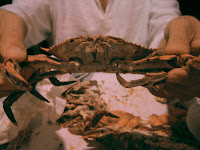 If you can’t find a favorite hometown food in New York City, do you a) return home as often as possible to eat it, b) learn to cook, or c) open a restaurant and start serving that hometown food to all New Yorkers?
If you can’t find a favorite hometown food in New York City, do you a) return home as often as possible to eat it, b) learn to cook, or c) open a restaurant and start serving that hometown food to all New Yorkers?
Fortunately for New York, hungry entrepreneurs have been answering “C” for centuries now. In the case of Justin Palmer of the Hideaway, first came the bar and restaurant, then came the bluefin crabs. Unable to find a place dedicated to serving hardshell crabs from Maryland or his native Virginia, he contacted his longtime crab supplier and started flying bushels of bluefins up every weekend. Now the Hideaway, a bar and restaurant started by four friends who wanted their own “clubhouse” in Tribeca, has become a mecca for transplanted crab lovers from up and down the Eastern seaboard.
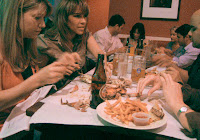 If you don’t know from crabs, you may think a restaurant like City Crab is enough. It’s not. A real crab shack doesn’t have newfangled things like sushi on the menu, nor should it dabble in crabs from here, there, and everywhere. As for places that specialize in Cajun food, do what you will with crawfish, but the words “crab” and “boil” should never appear next to each other. In a real crab shack, the tables are covered in paper, the paper’s covered in steamed bluefin crabs, the crabs are covered in Old Bay, and the diners are covered in crab. It’s seafood gluttony at its finest.
If you don’t know from crabs, you may think a restaurant like City Crab is enough. It’s not. A real crab shack doesn’t have newfangled things like sushi on the menu, nor should it dabble in crabs from here, there, and everywhere. As for places that specialize in Cajun food, do what you will with crawfish, but the words “crab” and “boil” should never appear next to each other. In a real crab shack, the tables are covered in paper, the paper’s covered in steamed bluefin crabs, the crabs are covered in Old Bay, and the diners are covered in crab. It’s seafood gluttony at its finest.
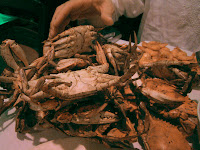 Do not be afraid if you don’t know how to tackle this crustacean. The Hideaway makes it easy, providing instructions for how to eat a crab on their menu, and chances are the diners at the next table would be more than happy to help out with tips. I would say you burn nearly as many calories opening them as you do consuming them, but we were served at least 15 crabs on our order of a dozen. The generosity didn’t stop there: the crabs were caked in Old Bay and steamed just right, even though the chef was working with a more difficult pot-on-the-stove system rather than the steamers dedicated to crabs that you see further south.
Do not be afraid if you don’t know how to tackle this crustacean. The Hideaway makes it easy, providing instructions for how to eat a crab on their menu, and chances are the diners at the next table would be more than happy to help out with tips. I would say you burn nearly as many calories opening them as you do consuming them, but we were served at least 15 crabs on our order of a dozen. The generosity didn’t stop there: the crabs were caked in Old Bay and steamed just right, even though the chef was working with a more difficult pot-on-the-stove system rather than the steamers dedicated to crabs that you see further south.
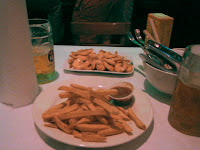 We also tried the shrimp and the fries, but both of these paled next to the succulent crabs. Non-seafood fans can opt for the hefty burger, which has been a draw at the Hideaway even before the crabs came.
We also tried the shrimp and the fries, but both of these paled next to the succulent crabs. Non-seafood fans can opt for the hefty burger, which has been a draw at the Hideaway even before the crabs came.
 Though Blue Crab Mondays have brought the Hideaway into the limelight, the place still retains its clubhouse feel. Led Zeppelin plays on the stereo, major league baseball plays on the TV, and the walls are decked with slick photographs of a young Mick Jagger, Jimi Hendrix, and Carolina basketball stars. (Several of the owners attended Duke.) When all the crabs were gone and the waitress had swept up the shell debris from under the tables, the chef, staff, and owners got together and did a shot behind the bar. Now this is the kind of place anybody could call home.
Though Blue Crab Mondays have brought the Hideaway into the limelight, the place still retains its clubhouse feel. Led Zeppelin plays on the stereo, major league baseball plays on the TV, and the walls are decked with slick photographs of a young Mick Jagger, Jimi Hendrix, and Carolina basketball stars. (Several of the owners attended Duke.) When all the crabs were gone and the waitress had swept up the shell debris from under the tables, the chef, staff, and owners got together and did a shot behind the bar. Now this is the kind of place anybody could call home.
The Hideaway
185 Duane Street, between Hudson and Greenwich Streets
New York, New York
212-334-5775
How To Eat a Crab:
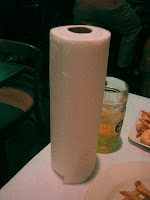 1) Make sure you have the necessary accoutrements: a mallet, paper towels, and beer.
1) Make sure you have the necessary accoutrements: a mallet, paper towels, and beer.
2) Remove the claws and legs.
3) Pull off the pointy underside piece, the “apron.”
4) Slide your thumb in the opening between the crab body and top shell. 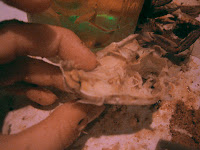 Pull off the shell.
Pull off the shell.
5) Tear off the spongy “lungs,” scoop out the “mustard” (the gunk in the cavity), and discard all.
6) Crack the crab body in half with your hands.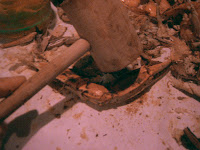
7) Pry away any of the overlying thin shell and dig into the body to extract the crab meat, then fan each half apart to get at the inner cavities.
8) Use the mallet on the claws only, tapping hard enough on 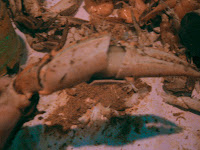 the upper part of the claw to break it but not so hard as to pulverize the meat underneath.
the upper part of the claw to break it but not so hard as to pulverize the meat underneath.
9) Save the fiddly legs for the end of the crab feast and deal with them only if you are still hungry.
Da Silvano
 “That’s him,” High Maintenance whispered.
“That’s him,” High Maintenance whispered.
I turned around as subtly as possible to see an older gentleman in a lime green top and matching lime green glasses enter the restaurant at about 9pm.
Silvano had arrived.
It wasn’t the only celebrity sighting of the night – Rihanna later emerged from the depths of the restaurant to be pounced on by paparazzi waiting outside with video cameras – but it was the most exciting. It would have been hard to recognize Silvano from his svelter illustrated portrait on the Da Silvano balsamic vinegar or the Da Silvano water. Yet this was the man who has been able to lure celebrities here consistently for years now (for details, see his site and photo album), even though Da Silvano is, well…not known for the food.
 Not all of it is bad, but Da Silvano is a lesson in levels of access and being in-the-know, in keeping with the celebrity theme. One of the best dishes wasn’t even on the menu. When High Maintenance ordered a caprese salad, I asked the waiter why this popular choice wasn’t listed with the rest of the salads.
Not all of it is bad, but Da Silvano is a lesson in levels of access and being in-the-know, in keeping with the celebrity theme. One of the best dishes wasn’t even on the menu. When High Maintenance ordered a caprese salad, I asked the waiter why this popular choice wasn’t listed with the rest of the salads.
“Everyone knows we have it,” the waiter said, in his signature blasé manner. Oh, of course. “Everyone.”
 At least the caprese was good. The firm exterior of the freshly made mozzarella yielded to a soft, slightly salty inside. I couldn’t determine the provenance of the tomatoes due to Italian-American translation difficulties. (How do you say “heirloom” in Italian?) But the waiter agreed that the tomatoes were “speciale” (my word).
At least the caprese was good. The firm exterior of the freshly made mozzarella yielded to a soft, slightly salty inside. I couldn’t determine the provenance of the tomatoes due to Italian-American translation difficulties. (How do you say “heirloom” in Italian?) But the waiter agreed that the tomatoes were “speciale” (my word).
 Oddly, the tomato bruschetta consisted of untoasted bread that was difficult to manage, though both bread and tomatoes were good separately. Not so for the panzanella – bread salad with tomatoes – which was quite disappointing if you’ve ever had the real thing. (It’s easy to make, too: For a recipe check out Rogers & Gray’s Italian Country Cookbook.)
Oddly, the tomato bruschetta consisted of untoasted bread that was difficult to manage, though both bread and tomatoes were good separately. Not so for the panzanella – bread salad with tomatoes – which was quite disappointing if you’ve ever had the real thing. (It’s easy to make, too: For a recipe check out Rogers & Gray’s Italian Country Cookbook.)
 “This is good, isn’t it?” High Maintenance said.
“This is good, isn’t it?” High Maintenance said.
“No,” I countered.
“But it’s good, isn’t it?” she repeated.
“Needs more garlic or onion.”
It also seemed to contain a lot of white wine vinegar, an odd choice that made the panzanella taste more British than Italian. Broccoli rabe sauteed with pan-roasted garlic was spot on, but the sausage that topped it off was dried out.
But forget about the food. We were here to dine outdoors (the summer theme of Gastro Chic), people watch, and drink wine. As for the reds, there were not a lot of offerings under $100, which annoyed me given Otto’s ability – and, OK, Morandi‘s – to find excellent Italian reds at inexpensive prices. The Le Cupole was a good wine at $95, the Sondraia a great one – bigger, more complex, and slightly more tannic – for $120.
 In the entree category, the pastas fared well. The rigatoni focaccia was the best of the bunch, with its cream and tomato sauce of double smoked bacon perfumed with sage. All this dish needed was more of the excellent sauce. Sage also played a big part in the success of the ravioli bella Firenze, spinach and ricotta filled ravioli sauteed in butter and sage.
In the entree category, the pastas fared well. The rigatoni focaccia was the best of the bunch, with its cream and tomato sauce of double smoked bacon perfumed with sage. All this dish needed was more of the excellent sauce. Sage also played a big part in the success of the ravioli bella Firenze, spinach and ricotta filled ravioli sauteed in butter and sage.
 We took the train off the tracks a bit when High Maintenance’s fiancé Boob and I decided to split the roasted fillet of veal, exorbitantly priced at $95. Veal is already very delicate, but this roast was downright bland, and the gravy didn’t add much flavor at all. For tips on how to make veal gravy, the chef at Da Silvano should check out Marinella across the way on Carmine Street. If I had to do it again, I would order the grilled shell steak.
We took the train off the tracks a bit when High Maintenance’s fiancé Boob and I decided to split the roasted fillet of veal, exorbitantly priced at $95. Veal is already very delicate, but this roast was downright bland, and the gravy didn’t add much flavor at all. For tips on how to make veal gravy, the chef at Da Silvano should check out Marinella across the way on Carmine Street. If I had to do it again, I would order the grilled shell steak.
Good or bad, Da Silvano is truly Italian. A large part of the menu is given over to daily seasonal specials. A number of the diners here were speaking Italian, as was the staff. But the thing that really tipped me off to the true Italian-ness of Da Silvano – other than the photo of Silvano driving a sports car outside Modena – was a note on the bottom
of the menu, in all-caps: NO CHEESE SERVED ON SEAFOOD AT ANY TIME.
This food-induced rage about what’s correct is something you rarely see outside of Italy, the country where I was told “Cappucino doppo pranza non esiste, non esiste!” which loosely translates as: Not only is it incorrect to have a milk-based coffee drink at any time but breakfast, but cappuccino after lunch doesn’t even exist, it doesn’t exist!
Even though it is celebrity-driven, Da Silvano is approachable. Now that the maitre d’ she knew has departed for Morandi, High Maintenance and I had no special in at the restaurant, but she managed to make a reservation just like a regular person, and we were still given a nice table outside despite our non-celeb status.
 “The food is really good, though, don’t you think?” she said as we were leaving.
“The food is really good, though, don’t you think?” she said as we were leaving.
“I don’t think people are here for the food,” I said.
“But the food is good,” she insisted.
“Well…”
With that we walked out of the patio to the spot where Rihanna’s black SUV had just sped off into the night.
 Da Silvano
Da Silvano
260 Sixth Avenue, between Houston and Bleecker Streets
New York, New York
212-982-2343
 Note that the menu illustration is by Marisa Marchetto, Silvano’s wife, Cancer Vixen, and talented New Yorker cartoonist (“Beauty is life’s Easy Pass.”) Look closely and you can see her in one of the photos.
Note that the menu illustration is by Marisa Marchetto, Silvano’s wife, Cancer Vixen, and talented New Yorker cartoonist (“Beauty is life’s Easy Pass.”) Look closely and you can see her in one of the photos.The Hungry Cat
On Day 2 of LA trip, it was decided that we would go to the Hungry Cat. Its specialty? Chesapeake-style seafood. In Los Angeles.
I’m originally from Maryland. Whenever I go back to Baltimore, people there want to take me to someplace that is “really New York.” Here I was all the way across the country, and my friends wanted to take me to someplace with an East Coast seafood. There must be some universal human instinct to offer up your city’s own “authentic” food from the diner’s home state. I was reminded of Pete Wells’ entry in Diner’s Journal. When he offered to take a Texan to an NYC barbecue place, the Texan threatened to take him out in Texas for “Houston pizza.”
Very well. Houston pizza it was. Of course, I was halfway through the meal before I remembered Hungry Cat was supposed to be like Baltimore. Minimalist and sleek, set in an industrial space with an open kitchen and patio seating under heat lamps, the Hungry Cat is unlike anything Baltimore has ever seen.
There aren’t a lot of fancy drinks made with fresh-squeezed juices in crab shacks along the Chesapeake. Hungry Cat’s were damn good. The Hemingway Daiquiri could have been flown in from Key West. The mixologists here even feature a cocktail special of the night, which that night was a blood-orange-infused vodka drink made with vodka they had infused in house.
As they say in DelMarVa, we gots lots of ducks down on the wuter, but we don’t got no duck like Hungry Cat’s. The surf & turf special that night was crackly-skinned duck overlaid with creamy bread pudding mixed with smoked trout, served alongside a frisee salad. As our knowledgeable waiter put it, it was on the “extreme” end of the menu’s offerings, but also amazingly good. The salty crispness of the duck went surprisingly well with smoked trout. It was an impressively creative dish.
According to many an LA Chowhound user, Hungry Cat’s oysters are some of the best in town, so we ordered up a dozen of these. There were no Kumamotos, and only one variety, the Hama Hama, was West Coast, so I would have to order East Coast oysters here. This was initially disappointing until we tasted the Chincoteague oysters, which were large, plump and briny – definitely as good as any I’ve had in Maryland.
When our theatrical waiter delivered an enticing monologue about the lobster rolls, I turned to the Kobra, who lived in Boston.
“Are you going to get that?” I really wanted him to order it so I could see what he thought. The instinct to get someone to eat his hometown food somewhere else was kicking in.
“No,” the Kobra said. “I never order lobster rolls outside of Boston.”
And I passed on the crab cakes, since I never order crab cakes outside of Maryland. Wooed by the waiter’s reenactment of removing the cheek of an especially large deep-sea halibut, I ordered this dish. The fabled halibut cheek arrived as lightly breaded and fried hunks of fish tumbled onto more bread pudding. N.B. that I have never once encountered bread pudding on a Maryland menu, yet it was a recurring theme at Hungry Cat. I imagine it was a staple on the Eastern Shore around 1820.
Nevertheless, the bread pudding was quite good, as was the halibut. Presumably this was the fish version of Batali’s obsession with beef cheeks. As with beef, the cheeks were an especially tender and light cut of the halibut, and Hungry Cat’s were expertly prepared. The one disappointment was the morels on top. Though they added a lot of flavor to the sauce, the reconstituted mushrooms were still a little tough and chewy.
Oddly for a seafood place, the Hungry Cat is especially famous for its PUG burger, so named because one of the owners has a pug. He sure tastes delicious. A debate ensued about what made the PUG burger so good, other than that naughty dog that got sent to the hamburger factory.
“It’s the bacon,” Fellow WASP’s husband said.
“No, it’s the blue cheese,” Fellow WASP said.
The smoky flavor of the slow-cooked, chewy, fatty bacon – could it be applewood smoked, like the bacon from Huntington Meats? – was the first thing that struck me too, until I started to deconstruct the taste and wondered if the tang of blue cheese was the key. The sharpness of the cheese kept the whole thing from derailing into absolute fattiness. Each element was absolutely essential. Maybe burgers should never be made without blue cheese and bacon from now on. Unfortunately, we can’t credit an East Coast seafood place with inventing this dish either.
California Girl’s salmon dish looks intriguing, but I didn’t get to it until some of the key ingredients were gone, like this poached egg on top. The salmon itself was a little overcooked, but the buttery noodles that came with were good.
To anyone who grew up eating seafood on the East Coast, there might be something charmingly amusing about the Hungry Cat. Rarely have crab cakes been paired with fava bean puree and harissa aioli. Peel ‘n’ eat shrimp don’t usually appear on the same menu as caviar. Things that are plain and simple out East are a little more complicated here. Lest you think that the Hungry Cat is trying to make a silk purse out of a sow’s ear, however, you need only note that their respect for
the ingredients, however plain or fancy, is absolutely sincere. And by elevating them to a new level, the staff could even teach East Coasters a trick or two.
 The Hungry Cat
The Hungry Cat
1535 North Vine, at Sunset
323-462-2155
Also in Santa Barbara
Le Petit Marché
CLOSED
Though they play at seriousness, restaurants are just as vulnerable to irrational trends as fashion is. Remember the Belgian pommes frites craze? Towering food? Churrascaria? Reassuringly overpriced comfort food? Communal dining tables?
By no means am I saying I haven’t been prey to the same follies. I was right there with the rest of New York, pointing to a huge stack of broiled meat on a spear at Riodizio on Lafayette while trying to pronounce “caipiriña.” But there are some things you don’t realize are a trend until they’re gone, like knee-length skirts. Such is the case with French bistros. One day you wake up and Le Zinc has vamoosed, La Jumelle est disparu, Balthazar and Pastis are overrun with tourists, and Anthony Bourdain has definitely left the Les Halles building.
At least there’s a little neighborhood French bistro, Le Petit Marché, in Brooklyn Heights, if not in Manhattan. And when better to try it than Brooklyn Restaurant Week, which runs now through March 30th?
Aside from a long aluminum ventilation tube running down the middle of the room, Le Petit Marché is a good-looking place with all the trappings of a turn-of-the-20th-century bistro. The barstools are appropriately clad in oxblood leather, the tin on the ceiling may even possibly be original to the brownstone building, and the ornate flower arrangement on the bar reaches dizzying Daniel-esque heights.
The cocktail menu was reassuringly French. My Brooklyn friend and I tried an excellent, not-too-sweet kir royale, which Le Petit Marché garnishes with raspberries, and an intriguing fizzy Lillet, which was a mix of champagne and the famous French apertif. We eyed the elaborate flower arrangement. My Brooklyn friend recounted a dinner party thrown by her ex-pat friend, now enviably stationed in Paris, at which all the Parisian guests arrived with flowers, not in the deli wrapping that’s the norm in New York, but in oddly neat little bundles, completely pruned of all thorns and leaves. “The French are really anal about flowers,” the ex-pat explained.
The appetizers arrived. I can hardly ever find a good pork country paté in this post-bistro era. (Alas, Le Zinc’s was my favorite.) Le Petit Marché’s was the real thing, presented with two types of mustard, a handful of greens, toast, and cornichons. It could have used some more oomph, but the pistachios embedded in the meat were a creative country touch.
The chef’s name is Robert Weiner, more Brooklyn than French, but we’ll give him a break. After all, he studied under Christian Delouvrier at the grand old Maurice at Le Parker Meridien.
What stood out with the duck confit salad and all the meats and seafoods was freshness. Even in a confit state, the duck didn’t taste at all gamey, but pure and meaty. This was a welcome relief. As the crowds and chef talent have slowly retreated from Manhattan bistros, the quality of the ingredients has gone down, so that I’ve started to approach certain menu items with a distinct feeling of trepidation. You can dive fearlessly into the menu at Le Petit Marché.
One thing that seemed quintessentially French was Weiner’s skill with lentils and beans. The smoky, earthy, garlicky lentils, finished with a slight tang of vinegar or citrus, nearly stole the show from the duck they accompanied. Equally as rich as the lamb shank entree, pictured here, was the accompanying white bean ragout, which was overlaid with flavors of tomato, herbs, and shallot. Like the duck, the lamb was not gamey but tender to the point of falling off the bone.
I hesitated before digging into the escargots, and not just because they were piping hot. Would these be the canned sort that plagued inferior bistros? Those hard little lumps that serve only as a carrier for butter and garlic? Mais non! These escargots were fresh and plump, broiled just to the point of doneness and not a second more. The sauce was predictably buttery and garlicky. The moules frites too were just what they were supposed to be, cooked perfectly, bathed in a white wine sauce and speckled with flecks of garlic.
For dessert we tried the tarte tatin. This was the traditional French dessert, but with an edge: the soft chunks of apple, served with creamy cinnamon ice cream, were caramelized nearly to the point of burntness. The dish pushed the envelope but stayed firmly in French territory.
Which was exactly what I wanted. When a French bistro opened in Manhattan ab
out a year and a half ago, it sent me into a rage. Why? Because they have buffalo wings on the menu. Ce n’est pas français! My only hope for finding authentic French bistro fare in a new setting had been dashed. It was the kind of frustration you feel when searching endlessly for the most basic item of clothing, like a black turtleneck sweater, only to find that it’s no longer sold by any store, because it’s only a basic.
When you tire of the latest trends, head to Le Petit Marché, where authenticity is always in stock.
 Le Petit Marché
Le Petit Marché
46 Henry Street, between Cranberry and Middagh Streets
Brooklyn Heights
718-858-9605
This is the Brooklyn Restaurant Week menu – the whole prix fixe meal goes for $21.12. Quelle steal!

For borough-phobes. How to get there: Get in a cab and say: Henry and Cranberry Streets in Brooklyn Heights – it’s spitting distance from the Brooklyn Bridge. Or take the A/C to High Street or the 2/3 to Clark Street.

Morandi
Addendum 3/29/07: Now with Morandi’s controversial wine list! For an update on Morandi’s wines, please see this link.
When most people ask for restaurant recommendations, what they’re seeking isn’t about food at all. “It’s so-and-so’s birthday. Where should we eat?” “I’m only in New York for one night!” Or my favorite, “What’s the cool place to go now?” But if you respond by asking them East Side or West Side, Asian or Italian, you look like a dolt yourself. It’s not about just good food, good service, and a nice atmosphere. It’s an endless quest for a sophisticated, grown-up version of fun.
It’s apparent from the moment you walk in the door at Morandi that Keith McNally delivers just that, again, with his latest creation. As of this New York minute, the scene at Morandi is like Pastis’ in the good old days. There’s the trademark backlit bar with its glowing liquor bottles, accented this time by unfinished wooden beams instead of subway tile. Hearth-shaped brick arches inlaid with shelves of wicker wine casks define each wall. The surface of the bar is beaten copper, the tin ceilings are low – wait a minute, isn’t this just the ground space in a ’60 red brick building? Is Morandi really an Italian restaurant, or is it a McNally theme version of the same? Never mind. You’ll be too distracted by the undercurrent of jazz and the buzzy noise of conversation to notice.
Morandi’s chef, Jody Williams, wowed at Gusto with several dishes that reappear here, the carciofi (fried artichokes) and the polpetti (meatballs). I was a fan of her cooking at Gusto and still am here. But as for fried artichokes, call me a WASP, but they’re all smoke and mirrors to me. Artichokes are a vegetable. They’re good steamed and dipped in a bagna cauda. Fried plain, they seem underseasoned. I wanted to call a do-over and stuff them with cheese.
The olive ascolane, fried stuffed green olives, were like crazy Italian junk food, which doesn’t really exist. I’m not quite sure what’s in them, but they’re good. The focaccia gorgonzola e pere, focaccia with gorgonzola and Bosc pears, was somewhat misleading. It arrived on a cute little wooden board – was this a pizza or a focaccia? Though the pear and gorgonzola combination on top was great, an actual Italian would scoff at the bread, whatever it was, because it was floppy. Some things are always disappointing when floppy.
Sometimes a ray of pure genius would shine through, as with the polipetti e sedano, grilled octopus with celery and black olives. This seemed truly Italian. Why? Because, served whole on the plate, tentacles and all, it is identifiable as a once-live animal. My general rule of thumb with Italian food in New York is to order what sounds gross to most people, because it’s usually the best thing on the menu. A side benefit is that if you’re dining with girls, you often won’t have to share.
Back to the octopus: where, oh Lord, is the divinity in celery? I don’t know, but rarely has a chef elicited such a subtle, delicate flavor from a scattering of celery and olives, a warm vinaigrette, and a slightly charred octopus. I was transported. As at Gusto, Williams has an especially deft touch with seafood.
There were only two of us dining, due to a flu attack on the third, and the staff couldn’t have been nicer about the reservation change and the babysitter delay my mom friend suffered. In short, we were displaying the typical New Yorker pain-in-the-ass behavior that drives some restaurants crazy. Even though we were late sitting down, the waitress didn’t rush us after securing our orders. The busboys, though polite and efficient, were overly aggressive clearers. At some points I found myself literally gripping my plate so that no one would take my food away from me. I felt like a feral animal. This isn’t true of just Morandi though: the overly-aggressive-clearing trend is happening everywhere.
On to the entrees. The tagliatelle alla Bolognese was sufficiently Italian, but not anything to write home about. Sticking with my earlier rule, I ordered the coniglio in porchetta – that’s rabbit roasted in lardo and fennel pollen. Yup, that cute little bunny that’ll be coming round Eastertime. After he delivers your basket full of candy, I suggest you hunt him down and serve him up to Williams, because she really knows what to do with him. This dish was Mario-esque, what with the inclusion of lardo. Williams must have left the rabbit to roast for a long, slow time over garlic. Like the octopus, it was paradoxically complex yet straightforward, and very good.
Though he pings your subsconscious with bottles everywhere, I don’t like McNally’s approach to wine. Compared with even the most basic Mario joint, Morandi’s wine offerings are paltry – there’s not enough information about them on the list, maybe because they’re all pretty basic. The kitschy wine carafes with wicker bases are fun, but they’re also an indicator that wine isn’t exactly approached in the most reverential manner.
As the evening progressed and the place filled up and the noise level grew to a deafening din of beautiful people, I leaned in to talk to my friend and noticed that the table was small enough that we could still hear each other. But of course it was: McNally had anticipated this very moment. Somewhere, from behind the magic curtain, he knew that he would have to balance the desire for a buzzy place with the desire to have a conversation. Just as he knew how to make an excellent first impression: the glowing bar, the jazz hopping in the background, the smiling staff.
Everywhere I looked, there were hearth shapes. Didn’t I just read in the Times that hearth shapes appeal to “the ‘reptilian mind,’ the preconscious part of the brain where archetypes and primitive associations are imprinted”? And don’t you think that McNally already knew such things without having to read about them in the Times? When I walked back to the restrooms, I was happy to see that he had reverted back to single-sex washrooms so that I wouldn’t have to put on lipstick in front of some gawking guy. As soon as I had the thought, I knew: McNally was thinking the same thing. It was almost eerie, as if he were always right there looking over our shoulders.
It’s no accident that “McNally” has been compared to “McDonald’s.” It takes a lot of thought to pull off something that seems so effortlessly successful. Don’t both
er comparing Morandi to a “real” Italian restaurant: it was never meant to be one. That would be like going to Disney World and complaining that Cinderella is an actress. Look at the exterior of Morandi: It’s practically a stage set, like the American revenge on Italy for the trickery that was the spaghetti Western.
But even when you can see the strings of the master puppeteer working in the rafters, it doesn’t affect the overall feeling of well-being you get from Morandi. It’s not a coincidence that when many people ask for a restaurant recommendation, they can’t describe exactly what they want. It almost defies description, and that’s where McNally steps in and executes expertly every time. With Morandi, he taps into the collective fantasy of what a fun Italian restaurant should be and makes it real.
 Morandi
Morandi
211 Waverly Place at Seventh Avenue
212-627-7575
Related article: More on Morandi
The Copycat Chef: Mussels with Bacon and Peas from Angus McIndoe
 Many reviewers, amateur and professional, have raved about the mussels at Angus McIndoe. They’re true country comfort food, perfect for this time of year. As soon as I tasted the wonderful bacon-and-peas cream sauce, I thought of a recipe from The New Basics Cookbook, by the same authors of The Silver Palate: Pasta with Prosciutto and Peas, one of my all-time favorites.
Many reviewers, amateur and professional, have raved about the mussels at Angus McIndoe. They’re true country comfort food, perfect for this time of year. As soon as I tasted the wonderful bacon-and-peas cream sauce, I thought of a recipe from The New Basics Cookbook, by the same authors of The Silver Palate: Pasta with Prosciutto and Peas, one of my all-time favorites.  In a somewhat bastardized version of an Italian sauce, the prosciutto is sauteed slowly with butter and flour to make a light roux, then the cream and other ingredients are added. The Angus McIndoe cream sauce had the same bacony cohesiveness as the Rosso-Lukins version.
In a somewhat bastardized version of an Italian sauce, the prosciutto is sauteed slowly with butter and flour to make a light roux, then the cream and other ingredients are added. The Angus McIndoe cream sauce had the same bacony cohesiveness as the Rosso-Lukins version.
 The combination of mussels and cream was harder to source. Where did this come from? The recipe seems to owe more to Normandy, Brittany, and the Île de Ré, famed land of mussels, than Scotland. Anthony Bourdain’s version of mussels in cream sauce has many of the same qualities as the Angus McIndoe dish. By subtracting some of the particularly French ingredients – Pernod, for instance – I might find a reasonable facsimile of the Angus McIndoe version.
The combination of mussels and cream was harder to source. Where did this come from? The recipe seems to owe more to Normandy, Brittany, and the Île de Ré, famed land of mussels, than Scotland. Anthony Bourdain’s version of mussels in cream sauce has many of the same qualities as the Angus McIndoe dish. By subtracting some of the particularly French ingredients – Pernod, for instance – I might find a reasonable facsimile of the Angus McIndoe version.
I cooked the mussels in beer instead and added some of their cooking liquid to the cream sauce. Surprise: it was completely disgusting. Here I had bought a whole loaf of French bread to sop up the sauce, which I couldn’t even stand to eat. It was horribly bitter, especially with the addition of parsley. The lesson: don’t drink beer with cream. I thought I learned that over a decade and several White Russians ago, but I must have forgotten.
 Trying again, I took a page from Jacques Pepin and used his suggestion of Sancerre as an excellent cooking base for mussels. This worked a lot better. The final product, though, should really have a certain shine to it. The mussels at Angus McIndoe looked positively glazed, they were so shiny. This reminded me of Lidia Bastianich’s Linguine with Bacon and Onions, in which an egg yolk is added at finishing time to achieve a similar shiny, thick sauce.
Trying again, I took a page from Jacques Pepin and used his suggestion of Sancerre as an excellent cooking base for mussels. This worked a lot better. The final product, though, should really have a certain shine to it. The mussels at Angus McIndoe looked positively glazed, they were so shiny. This reminded me of Lidia Bastianich’s Linguine with Bacon and Onions, in which an egg yolk is added at finishing time to achieve a similar shiny, thick sauce.
For the first version of this dish, I used real live peas instead of frozen ones, but then I figured, why bother. At Angus McIndoe, the peas were so evenly sized that they must have been frozen, and the flavor of frozen thawed peas was actually better in this sauce.
 In a dish this simple, the quality of the ingredients is even more important. For the first attempt, I went to Wild Edibles on Third Avenue and 35th Street (also at Grand Central Market) for the mussels. The salesguy there was very helpful and friendly, explaining why they only sell Prince Edward Island mussels and even knocking each of them before putting them in a plastic baggie to make sure the ones he sold me were all alive. The next time around, I went to Citarella, whose mussels were almost as good, but where the service wasn’t quite as helpful. When I asked the Citarella salesguy where the mussels were from, he responded “Canada.” Last I checked, Canada is a pretty big country. (They were also from P.E.I.) But, miracle of miracles, Citarella apparently has caved to popular demand and is now stocking their freezer with items a little less esoteric than just edamame beans: they finally carry frozen peas and other frozen vegetables.
In a dish this simple, the quality of the ingredients is even more important. For the first attempt, I went to Wild Edibles on Third Avenue and 35th Street (also at Grand Central Market) for the mussels. The salesguy there was very helpful and friendly, explaining why they only sell Prince Edward Island mussels and even knocking each of them before putting them in a plastic baggie to make sure the ones he sold me were all alive. The next time around, I went to Citarella, whose mussels were almost as good, but where the service wasn’t quite as helpful. When I asked the Citarella salesguy where the mussels were from, he responded “Canada.” Last I checked, Canada is a pretty big country. (They were also from P.E.I.) But, miracle of miracles, Citarella apparently has caved to popular demand and is now stocking their freezer with items a little less esoteric than just edamame beans: they finally carry frozen peas and other frozen vegetables.
 I used Schaller and Weber Black Forest bacon, which is the best I’ve found in the city. You can get it on Fresh Direct, but you have to go to a nice off-line grocery store like Garden of Eden on 14th Street to get it sliced thin, which is very important for this recipe.
I used Schaller and Weber Black Forest bacon, which is the best I’ve found in the city. You can get it on Fresh Direct, but you have to go to a nice off-line grocery store like Garden of Eden on 14th Street to get it sliced thin, which is very important for this recipe.
A note to the fat-phobic: Though this is a seafood dish, it is decidedly not low-fat; in fact it’s pretty much a heart-attack-in-a-bowl. Attempts to make a lower-fat version, using half & half instead of cream, for instance, failed and are not recommended.
Mussels with Bacon and Peas à la Angus McIndoe
Time: 35 minutes
1.6 lb. mussels
1/4 lb. bacon, very thinly sliced
1 tbsp butter
1 tbsp flour
1 cup heavy cream
1/2 cup frozen peas, thawed
1 tsp sea salt
several grinds of black pepper
3/4 cup Sancerre or other dry white wine
1/2 cup water
1 egg yolk
Scrub mussels under running cold water with a wire brush until their shells are clean and shiny. Check for any bits of beard poking out of the shells, and pull them out. (You probably will not find many, if any at all, with P.E.I. mussels.)
Heat the butter until foaming in a wide saute pan. Add the bacon, stir a couple times, and reduce the heat to medium-low. Cook for 1 minute, then sprinkle the flour over top and stir again. Continue cooking for about 3 minutes, until the bacon is wilted and has rendered a good deal of its fat.
Whisk in the cream and raise the heat to medium-high. Continue whisking until sauce begins to bubble and thicken, about 1 minute. Whisk in peas, salt, and pepper, and turn the heat down to the lowest temperature.
Bring the wine and water to a boil in a roomy pot, preferably fitted with a glass lid. Add the mussels and boil 3-4 minutes until they all yawn open widely, shaking the pot every once in a while to redistribute the mussels.
Scoop them out with a big wire skimmer, then carefully decant 2/3 cup of the cooking liquid, leaving any sandy residue at the bottom of the pot. Whisk the cooking liquid into the cream sauce, raise the heat to medium-high, and continue whisking 1 minute until the mixture begins to bubble and thicken again. Turn off the heat and mix in the egg yolk, then then mussels in their shells, tossing to mix the sauce evenly throughout.
Serve immediately with crusty country bread.
Serves 2.
Angus McIndoe
 As any humble (or seemingly humble) actor will tell you, so much of making it in the theater depends on being in the right place at the right time. So I felt especially fortunate when I happened to be at a restaurant on 44th Street when the entire cast of The History Boys stopped in for a pint after their last performance, the one I had just seen, with a television crew trailing behind. Angus McIndoe was exactly the right place to be.
As any humble (or seemingly humble) actor will tell you, so much of making it in the theater depends on being in the right place at the right time. So I felt especially fortunate when I happened to be at a restaurant on 44th Street when the entire cast of The History Boys stopped in for a pint after their last performance, the one I had just seen, with a television crew trailing behind. Angus McIndoe was exactly the right place to be.
 An upscale Scottish pub, Angus McIndoe (pronounced MAC-indoo) was the subject of a Times story when Matthew Broderick and Nathan Lane first starred in The Producers. They ate at Angus McIndoe nearly every night, and when Nathan Lane couldn’t make it to the restaurant itself, he ordered in. Whenever Angus McIndoe, the eponymous owner, called to see how Nathan Lane’s meal was, he replied, “Surprisingly good.”
An upscale Scottish pub, Angus McIndoe (pronounced MAC-indoo) was the subject of a Times story when Matthew Broderick and Nathan Lane first starred in The Producers. They ate at Angus McIndoe nearly every night, and when Nathan Lane couldn’t make it to the restaurant itself, he ordered in. Whenever Angus McIndoe, the eponymous owner, called to see how Nathan Lane’s meal was, he replied, “Surprisingly good.”
 The food is in fact surprisingly good for the theater district, where most restaurants have no qualms about keeping it mediocre, presumably thinking they won’t ever see these damn tourists again. But Angus McIndoe is the sort of place people come to once, then again, then over and over, not just because the food is good – though a little uneven – but because each night there is a frisson of behind-the-scenes excitement. You can almost imagine Eve Harrington stopping by for a drink – or poisoning Bette Davis’. After the shows, many of the stars arrive for a late dinner, and beforehand, the real producers fill the seats.
The food is in fact surprisingly good for the theater district, where most restaurants have no qualms about keeping it mediocre, presumably thinking they won’t ever see these damn tourists again. But Angus McIndoe is the sort of place people come to once, then again, then over and over, not just because the food is good – though a little uneven – but because each night there is a frisson of behind-the-scenes excitement. You can almost imagine Eve Harrington stopping by for a drink – or poisoning Bette Davis’. After the shows, many of the stars arrive for a late dinner, and beforehand, the real producers fill the seats.
 With all of this hullabaloo, it’s fortunate that wine is always served immediately and as a quartino, so pre-theater diners don’t have to suffer anxiety pangs wondering if they’ll be able to order a second glass of wine before they have to bolt. Upstairs and downstairs are equally entertaining places to sit, depending on the hour – upstairs is better later.
With all of this hullabaloo, it’s fortunate that wine is always served immediately and as a quartino, so pre-theater diners don’t have to suffer anxiety pangs wondering if they’ll be able to order a second glass of wine before they have to bolt. Upstairs and downstairs are equally entertaining places to sit, depending on the hour – upstairs is better later.
 On a preliminary visit for this review, I find the food not as surprisingly good as I remembered, however, perhaps because the kitchen is serving a large private party on the top floor at the same time. The all-day breakfast plate, which has been reliable in the past, doesn’t thrill like the first time. The pork-apricot sausages that sound so good on the menu seem pre-cooked and warmed over, and the “potato scone” prompts my friend to say, “This isn’t a scone. This is fried mashed potatoes.” Overall she pronounces the dish “all right.” The tasting plate, part of the nightly special menu, manages to be uneven all on one plate. The country pork paté with cornichons could be my new favorite, but the smoked salmon is bland and the grilled shrimp smells fishy. The hamburger with Boursin cheese sounds intriguing. There is a little too much Boursin caked on top when it arrives, but it’s a nice combination, and the burger itself is great – ground sirloin with a little Worcestershire sauce thrown in, just to add a touch of Great Britain to the mix.
On a preliminary visit for this review, I find the food not as surprisingly good as I remembered, however, perhaps because the kitchen is serving a large private party on the top floor at the same time. The all-day breakfast plate, which has been reliable in the past, doesn’t thrill like the first time. The pork-apricot sausages that sound so good on the menu seem pre-cooked and warmed over, and the “potato scone” prompts my friend to say, “This isn’t a scone. This is fried mashed potatoes.” Overall she pronounces the dish “all right.” The tasting plate, part of the nightly special menu, manages to be uneven all on one plate. The country pork paté with cornichons could be my new favorite, but the smoked salmon is bland and the grilled shrimp smells fishy. The hamburger with Boursin cheese sounds intriguing. There is a little too much Boursin caked on top when it arrives, but it’s a nice combination, and the burger itself is great – ground sirloin with a little Worcestershire sauce thrown in, just to add a touch of Great Britain to the mix.
 On another day at lunch with a friend who works for a certain newspaper whose Times Square offices are right above Angus McIndoe, the kitchen is running on an even keel. We have oysters similar to Kumamotos, with the same fluted shell and delicate, sweet taste. The presentation on a bed of chipped ice is very pleasing, though not so for the shrimp cocktail, which is served a plate of rather sad mesclun. Neither of us likes the chipotle dip that comes with the shrimp alongside the usual cocktail sauce, but then again, I am a traditionalist and don’t tend to encourage things like chipotle sauce with shrimp cocktail. We also order chili with our three seafood appetizers, and the waitress doesn’t blink an eye, perhaps assuming we are stoned.
On another day at lunch with a friend who works for a certain newspaper whose Times Square offices are right above Angus McIndoe, the kitchen is running on an even keel. We have oysters similar to Kumamotos, with the same fluted shell and delicate, sweet taste. The presentation on a bed of chipped ice is very pleasing, though not so for the shrimp cocktail, which is served a plate of rather sad mesclun. Neither of us likes the chipotle dip that comes with the shrimp alongside the usual cocktail sauce, but then again, I am a traditionalist and don’t tend to encourage things like chipotle sauce with shrimp cocktail. We also order chili with our three seafood appetizers, and the waitress doesn’t blink an eye, perhaps assuming we are stoned.
 The chili is good, fired under a broiler until the cheddar cheese melts on top, then sprinkled with crispy bits of bacon that really make the dish. It adds the same crunchy texture crackers would, but with the bonus of contributing flavor. The pork chop is not as exciting, and my friend calls it “a little dry.” I blame the matinee ladies. It is Wednesday, after all, and hordes of tourists have just eaten here, probably demanding pork chops cooked to at least 180 degrees Fahrenheit. This chop is a little pink but not alarmingly so.
The chili is good, fired under a broiler until the cheddar cheese melts on top, then sprinkled with crispy bits of bacon that really make the dish. It adds the same crunchy texture crackers would, but with the bonus of contributing flavor. The pork chop is not as exciting, and my friend calls it “a little dry.” I blame the matinee ladies. It is Wednesday, after all, and hordes of tourists have just eaten here, probably demanding pork chops cooked to at least 180 degrees Fahrenheit. This chop is a little pink but not alarmingly so.  I don’t think it’s half bad, but it’s not as good as the pan-roasted free-range chicken, pounded thin like chicken paillard and seared on the outside, juicy within. The mashed potatoes that accompany it are so smooth and buttery I would almost accuse them of being fakes, if they were not Angus McIndoe’s, which, though it is not Irish, does know its potatoes. Any guilt from eating mounds of mashed potatoes can be assuaged by forking up the garlicky sauteed kale served alongside.
I don’t think it’s half bad, but it’s not as good as the pan-roasted free-range chicken, pounded thin like chicken paillard and seared on the outside, juicy within. The mashed potatoes that accompany it are so smooth and buttery I would almost accuse them of being fakes, if they were not Angus McIndoe’s, which, though it is not Irish, does know its potatoes. Any guilt from eating mounds of mashed potatoes can be assuaged by forking up the garlicky sauteed kale served alongside.
 The phenomenal steamed mussels with bacon and peas are the pinnacle of the meal, the pinnacle of any of my meals at Angus McIndoe over the years. The mussels themselves are little and sweet, dunked in a creamy sauce flavored by the thin, limp folds of bacon and fresh peas. I devour nearly the entire thing myself and start dreaming of the next Copycat Chef recipe…
The phenomenal steamed mussels with bacon and peas are the pinnacle of the meal, the pinnacle of any of my meals at Angus McIndoe over the years. The mussels themselves are little and sweet, dunked in a creamy sauce flavored by the thin, limp folds of bacon and fresh peas. I devour nearly the entire thing myself and start dreaming of the next Copycat Chef recipe…
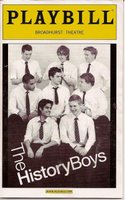 The History Boys don’t show up for this meal or for the one before. They come to Angus McIndoe when I’m there by chance, because we’re looking for a good place to have an after-theater drink in the neighborhood, and Angus McIndoe is a good place. It’s this kind of loyalty, almost reflexive at times, that can pay off in the theater district, where sometimes kismet is of your own making.
The History Boys don’t show up for this meal or for the one before. They come to Angus McIndoe when I’m there by chance, because we’re looking for a good place to have an after-theater drink in the neighborhood, and Angus McIndoe is a good place. It’s this kind of loyalty, almost reflexive at times, that can pay off in the theater district, where sometimes kismet is of your own making.
 Angus McIndoe
Angus McIndoe
258 West 44th Street
between Eighth Avenue and Broadway
212-221-9222
Corrections amended: A Mr. McIndoe wrote in to inform this geographically-challenged American that Angus McIndoe is in fact Scottish, not Irish, which I would have realized had I carefully reread the Times article cited. Therefore, some phrasing in this review has been changed from “Irish” to “Scottish,” “of or belonging to Great Britain,” or simply “not Irish.” Gastro Chic is horribly embarrassed by the error.









